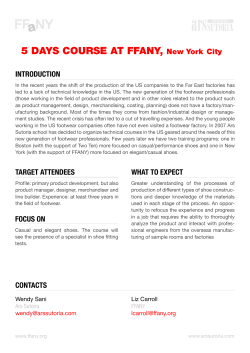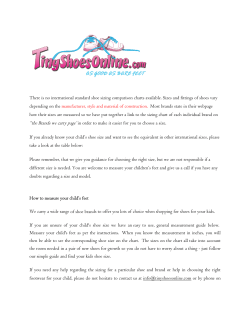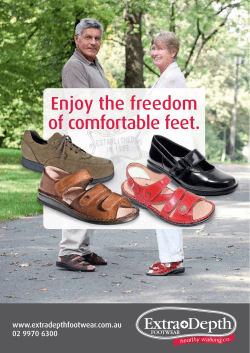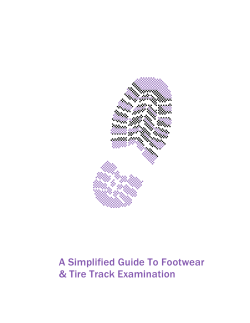
LEONARDO DA VINCI PATTERN MAKING AN EDITORIAL CONCEPT OF THE
LEONARDO DA VINCI Community action programme on vocational learning Strojarska ulica 2, 4226 Žiri (SI) Supporting program: Leonardo da Vinci – Transfer of innovation Project: SHOE FUTURE AN EDITORIAL CONCEPT OF THE HANDBOOK FOR THE MODUL: PATTERN MAKING Prepared by: Ars Arpel Date: CHAPTERS OVERVIEW 1 SHOE LAST ..........................................................................................................2 1.1 1.2 1.3 1.4 2 Categories of lasts by the shoe construction process.................................................. 3 Shoe last standard making ........................................................................................ 12 Last measurements and last evaluation ................ Napaka! Zaznamek ni definiran. Technical reference points for design ....................................................................... 13 MANUAL PATTERN MAKING ......................................................................14 2.1 2.2 3 Mean form of the last................................................................................................ 14 Style and pattern making .......................................................................................... 19 MODEL PATTERN MAKING .........................................................................25 3.1 3.2 4 Categories of pattern making methods for classic modelsNapaka! Zaznamek ni definiran. Categories of pattern making methods for casual modelsNapaka! Zaznamek ni definiran. COMPUTER AIDED PATTERN MAKING...................................................25 4.1 4.2 Available software solutions on the market ......... Napaka! Zaznamek ni definiran. Options of using CAD for pattern making ........... Napaka! Zaznamek ni definiran. 1 Introduction Pattern making is the process of creating the ‘Project’ of the shoe upper made by the various parts of upper and lining, so that these can be cut from leather or another material and then joined together by sewing to form the desired 3D shoe design. But pattern making also extends to other components, such as the insole, heel and wedge covers or other components in case of particular shoe constructions. The pattern maker will take the 3D design drawn onto the last , or drawn onto the 2D mean form of the last or drawn on paper and convert it into a series of 2D shapes (board made or digital format). Initially , patterns are made in one size (the sample size) and then they are ‘graded’ (made smaller and bigger) to cover the full size range of shoes to be produced. It is important to say that only the size of every piece will vary, while the design will never change. To be a good pattern maker it is fundamental to understand all the production processes of the footwear making. He should have spent time working in every department of the factory. This is just to give a better idea of where problems can be hidden when shoe designs are in production. When the sample patterns are not well done or the grading has not been made correctly, the final footwear doesn’t fit the last, or shoe machineries don’t work properly or the shoe doesn’t fit the foot. That’s why a deep knowledge of traditional pattern making technique is required together with the most updated CAD CAM technologies and softwares used for footwear design. 1 SHOE LAST The shoe last must be manufactured by thinking of two different points of view: styling and manufacturing. The designer thinks about a last, at the beginning, as a shape given to the shoe and this is focused on a concept composed by last, heel and outsole. On the opposite, the shoe factory must buy sets of shoe lasts conceived as tools for production. This means the sample size last has to be size graded according to different systems of measurement and with the typical mechanical characteristics to be used as a production tools. In other words, with hinges, sliding mechanism, scoop blocks, bottom metal plating and so on. At the same time the last design is a combination between the needs of the footwear designer and the technical skills and knowledge of the last designer. These features are strongly connected to the type of shoe to be produced and the construction required. As it will be better explained in the following chapters, constructions are many, different and also customized so, the design of lasts has to take into account the way patterns for production will be technically made. Several are the pattern making systems but only the most adequate to volumes and geometry of the last is allowing a perfect fit to the last itself and, later, to the foot. Besides, comfort and appeal, for every size delivered, should be a perfect mix to consider a consistent and successful shoe production. 2 1.1 Categories of lasts by the shoe construction process Lasts for men’s and women’s cemented construction Example of footwear made by Cemented construction Key characteristics of the construction 1. Fast and easy to engineer 2. It is a versatile construction, for men’s women’s and children’s 3. Any upper and outsole material can be used 4. Lightweight footwear Example of lasts for Cemented construction Key characteristics of last for this construction: 1. Good quality of plastic material 2. Correctly prepared for lasting and de-lasting the shoe 3. Corrected proportions matching with foot volumes 4. Heel, waist, or full metal bottom plating 3 Lasts for Goodyear-welted construction Example of footwear made by Goodyear-welted construction Key characteristics of the construction: 1. Hard and heavy at the beginning but extremely flexible and comfy after use 2. Very expensive because of the quality of materials and steps of construction 3. Very classical styles but also innovative 4. Not advised for casual Example of last for Goodyear-welted construction Key characteristics of last for this construction: 1. Good quality of plastic material 2. Correctly prepared for lasting and de-lasting the shoe 3. Corrected proportions matching with foot volumes 4. Specific bevel along the feather edge and heel metal plating 4 Lasts for Stitchout and S. Crispino construction Example of footwear made by Stitch out and S.Crispino construction Key characteristics of the construction: 1. Light and flexible 2. Suitable for unlined and summer shoes 3. Specific equipment 4. Stitched upper and outsole Example of last for Stitch out and S. Crispino construction Key characteristics of last for this construction: 1. Specific preparation of feather edge 2. No bottom metal plating 3. Corrected proportions matching with foot volumes 4. Physical adjustments for a better fitting due to different lasting 5 Last for opanka construction Examples of footwear made by Opanka construction Key characteristics of the construction: 1. in case of leather outsole is very expensive and more difficult to make 2. in case of rubber outsole easier, cheaper and fast 3. flexible and elastic fitting 4. versatile: dressy and casual, for several styles Example of last for Opanka construction Key characteristics of last for this construction: 1. Sharp feather edge 2. Thick volume of toe 3. Tool for outsole moulding 4. Difficult to adapt existing outsoles 6 Lasts for moccasins Example of Moccasin Key characteristics of the construction: 1. Flexibility 2. Unique style and appeal given by a specific stitching 3. Very cheap or highly expensive 4. Both handmade or industrially stitched Example of last for Moccasin Construction Key characteristics of last for this construction: 1. Sharp feather edge 2. Thick volume of toe 3. Length must be reduced 4. Difficult to adapt existing outsoles 7 Lasts for Sol California / Slip lasting construction Example of footwear made by Sol California and Slip Lasting Construction Key characteristics of the construction: 1. Softness and high flexibility 2. Less contents of industrial process 3. Labour intensive construction 4. Suitable of several variations Example of last for Sol California and Slip Lasting construction Key characteristics of last for this construction: 1. 2. 3. 4. Sharp feather edge Advisable flat and slender toe Advisable mechanical hinge for lasting Minimal difference between inside and outside waist shape 8 Lasts for Strobel construction (casual and safety) Example of footwear made by Strobel Construction Key characteristics of the construction: 1. Lightness and flexibility 2. Specific construction suitable both for cemented and direct injection outsole 3. Labour intensive but cheaper than others 4. Fast and used for several products Example of lasts for Strobel Construction Key characteristics of last for this construction: 1. Sharp feather edge 2. According to type of shoe specific features of volumes and geometry to unease pattern making and construction too 3. Advisable mechanical hinge for lasting or similar tools 4. Minimal difference between inside and outside waist shape 9 Lasts for Vulcanized Built-up Construction Example of footwear made by Vulcanized Built up Construction Key characteristics of the construction: 1. Combination of Cemented and outsole Vulcanization 2. Outsole made of actual rubber and advisable fabric uppers 3. Flexibility 4. Easy to wash clean without any damage for the outsole Example of last for Vulcanization Key characteristics of last for this construction: 1. Made in aluminium 2. Empty cavity to get fast warm up 3. No need to change it very often according to fashion trends 4. High quantity footwear production required 10 Lasts for direct injection construction Example of footwear made by outsole Direct Injection Key characteristics of the construction : 1. Extremely technical and out of tradition 2. Difficult pattern making and size grading 3. High cost of moulds and equipment versus cheap product 4. High production required Example of lasts for Direct Injection Key characteristics of last for this construction: 1. Different type of plastic, more expensive 2. If metal foot last is used, expensive tool and complex engineering 3. Customized de-lasting mechanism 4. Investment of sets of last related to amount of production cycles 11 1.2 Shoe last standard making 1.3 Last measurements and last evaluation The first step is to convert the 3D shape of the last into a flattened 2D shape which is usually called ‘Mean form’. When style lines and the lasting allowance are added into the 2D shape of the last, the form can be called ‘Standard’ which is the completed footwear project of the upper. Then, the patterns are cut out from this and stitched together to create the 3D footwear design. These steps are made for the typical sample size which is 42 EU for men’s and 37 EU for women’s. (or their equivalent for English size and USA size). But firstly, the last must be controlled and evaluated by using refences of measures considered as a ‘starting point’ 12 1.4 Technical reference points for design There are many ways of making the form but all follow the same system of finding some reference points and lines along the surface of the last . Then the masking tape is used to cover the surface of the last and then removed to be flattened. Mark the outside and inside tangent points along the feather edge. Then, by the measuring tape trace the fitting line and the ‘Last Fitting Point’ (LFP) 13 2 2.1 MANUAL PATTERN MAKING Mean form of the last Tape the ouside of the last by the masking tape. Remove the paper in excess along the top line, the bottom feather edge and along the two center lines. Then detach it carefully. This process is critical because you may cause an incorrect stretching of the masking tape. 14 As the operation can cause an abnormal deformation of the tape, before attaching on cardboard make some slots in the paper in order to reduce the stress given by the 2D flattening The method taught uses a system of pattern ‘springs’. Single or double slots that will rotate the toe of the form in order to prepare the shape of the patterns during lasting. After the 2D flattened shape has been sprung it is advisable to cut the two halves of the last in paper to check out the proper shape. Length, width and spring must correspond to the 3D shoe last. 15 When testing the last fit the paper shouldn’t be pulled too much. Just lay down it and watch the shape of the natural wrinkles. The same test can be carried out in leather or fabric but this doesn’t not show the same way. Paper has no elasticity and rips if not properly shaped. When the fitting is not satisfactory it is necessary to make some adjustments. A method of cuts, darts and allowances given is enough to fine tune the 3D cover. 16 Most of the time, the inside and the outside of the last are different in volumes and shapes and so the corresponding 2D halves. The paper trial is now fundamental to understand where and how to modify the 2D forms. In this picture the pattern maker is showing where to remove and where to add the allowances along the inside asymmetrical feather edge. To complete the mean form making process, the back counter line must be retraced. The 2D flattened form fits well but the the back seat needs more tension given during lasting the shoe. In this picture the use of particular templates help this process. 17 The final Mean Form is made. It is called ‘Unified Form’ including inside and outside differences. But this must be completed with the tracing of construction lines and reference points. These are necessary to convert sketched lines into technical and functional lines making the patterns of upper and lining. In other words to be able to transform an idea of a shoe into a proportionate styled and fitting product. This is the general explanation of how to make a mean form of a last. This process is used when a pattern base for Cemented construction is needed. However, there are differences in term of taping, flattening and springing according to the different construction followed. More in detail: - Standards Vulcanized built up construction tape the aluminium last no need to spring in case of lace to toe derby or long oxford Standards for Stitch out and S. Crispino construction different back preparation because the lasting machine will stress and elongate less the upper Standards for Moccasins the masking tape has to cover the three surfaces: outside, inside and bottom of the last the flattening is completely different because the lasting follows a specific process Standards for Sol California/Slip lasting construction The masking tape must be placed in a different way onto the last The spring can occur or not, depending on the type of Sol California The bottom pattern making must be matching with the outside and inside perimeters. Standards for Strobel construction, casual shoes Very similar to Sol California but submitted to different type of bottom-upper assembling. Tolerances of elasticity and upper strength must be considered Springs are not needed 18 2.2 Standards for Strobel construction, safety shoes This flattening is very complex because of the volumes and performance of the special last used Many steps will concur to define the pattern base including a very accurate subdivision of the reference notches used for assembling uppers to insoles Springs are not needed Standards for Strobel variations Any variation of this construction will determine a different way to prepare the pattern base. Besides, depending on the type, several fine tuning steps must be used to make a perfect to fit last standard Springs are not needed Style and pattern making Making a men’s Derby Trace the LFP perpendicular and the side construction lines by using the measuring tape 19 Measure and mark the top quarter height in order to have the main references for the Derby design. These proportionate values are given by the method of pattern making and design which divides rules, measures, spring systems according to styles and reaction during lasting the uppers. This picture shows, again, one of the most critical steps of the process. The style drawn onto the last is now flattened to be part of a Standard. Stessed and compressed areas must be better controlled because of the design. Every bad move will probably affect the design and the technical patterns cut from this. 20 The method needs a Derby spring in order to prepare the patterns before making. There is a chart of springs used for the most used shoe constructions and styles. This is the key of understanding not only the best way of pattern making but also how to solve upper and lining fitting issues in production. Lines traced on the standard indicate the pieces that will appear on the finished shoe. However, other lines must be added on the standard allowing the vamp to be made in one piece, extra materials for folds and seam underlays and allowances for lasting the upper upon the construction. From this all the patterns are made and this could also be considered as the ‘project’ of the footwear. A lining standard with the adding allowances 21 Vamp pattern making: fold in two a piece of cardboard, ensuring that the crease line is sharp. This allows the proper allignment of the quarter onto the vamp. Allign the standard axis along the crease line and mark around the inside, outside lasting allowance, the edge of the quarter and the tongue edge. Then remove the standard and cut around the pattern marks. Quarter pattern making: Place the standard onto the cardboard and draw around the lasting edge, back line, top line and eyelet holes. Using dividers add a folding allowance along the topline and a seam allowance in case a closed seam is required. 22 Lining heel pocket pattern making Take a piece of board for patterns, make a sharp crease line and allign the edge of the standard including the heel pocket. As per the picture allign it from the topline until 2 cm. from the bottom edge. Mark around the top line, the straight style line and the feather edge. Remove the standard and cut the double paper in order to make a symmetric and specular pattern. Then, an underlay allowance is added. Upper paper trial for style and fit analysis Lining paper trial for style and fit analysis Complete paper simulation before board pattern making 23 Cardboard upper patterns ready for cut Cardboard lining patterns ready for cut Example of an envelope (pakage) including a technical sketch and notes for assembling What is grading? This is the term applied to the proportional enlargement of reduction of a pattern to accomodate the different sizes in a production range. Since the shoe last is the basis for shoemaking, the way the patterns for upper and lining are graded must follow the last grading Digital patterns ready to be graded Standard grading 24 The process must be done by following some basic rules and principles, being part of the class. Grading can be carried out, today, by CAD CAM software system. Whatever method is used the goal is always the same. Reproducing the shape of the patterns in different sizes without changing the original proportions. By the way some ‘restrictions’ are needed to ensure a good fit and appearance. Graded package Graded pieces The derby is among one of the first project to be learned. It contains several basic rules of design and a specific type of spring useful to better understand the method taught. A fundamental principle is given by learning that for every style some general steps are followed but, at the same time, new and particular details of design and pattern making have to achieved to complete the projet. For example: a pump, the typical footwear for women, has different proportions than a women’s derby. Different design and different way of lasting. The specific spring used for making it during the construction is typical and adaptable to several styles depending on the design. So for that, women’s derby, men’s oxford, sandals, boots and so on. If one wants to learn in detail the full method of design and pattern making, has to join and attend the course of Ars Sutoria in Italy, Milano. This training has a duration of 12 weeks during which every detail belonging to any style, from the classical to the most updated and performing will be learned. 3 COMPUTER AIDED PATTERN MAKING Footwear design, pattern making and size grading can be facedby using softwares, in different ways: 1. Digitizing of patterns and cut: this is the easiest solution. Among the advantages the fact that is fast for who just wants to cut out the graded pieces of upper and lining. 25 It is a very simple software useful for size grading as well. Some disadvantages are, for example, the fact that for every new item a new digitizing is required. According to the amount of pieces this will take less or more time to engineer and cut by a continuous cutting machine. There is no possibility of rebuild the standard by assembling the digitized pieces because they have been made by hand and than “copied” just to be considered as a file. So, it will not be possible to change the shape of the pieces if a variation of the stile is required. The only solution will be remake the pieces by hand and re-digitize them again. 2. Digitizing of the standard (style lines), pattern making and size grading: This is the most complete way of working by the 2D system. The project is designed by hand and digitized. Pattern making is obviously consequent and any change of the style lines will automatically change the patterns made. Size grading is covered in any aspect and the connection between the standard and the pieces will be reflected to the graded sizes as well. Some software also give the possibility of swapping stiles from one standard to another ( so from different lasts) only by some simple operations. 3. Digitizing of the last, flattening, standard making, 3D design, pattern making and size grading. This is what a complete 3D software can make and assist the updated designer or technician. Actually, nowadays,s this is not the most followed solution in the footwear world, because they always have preferred the 2D software. Easier and faster. But not only because of these aspects. The main problems faced have to be referred to some years ago when it was too complicated to obtain high quality of digitized lasts. Besides, the level of skills of the operators have increased very much only in the last years. We are, today, watching a new trend: the 3D footwear design is getting more relevant and effective thanks to the use of the virtual reality, moreover already experienced in the past, but not ready yet to be accepted by the operator of this field. 3D functions are also helping dramatically the drafting of technical bills especially for those production plants matching with organization problems due to complex systems among the Product Development Department, Marketing and Production same. To end, some systems existing on trade are able to cover each of these aspects with complete functions but in different ways. It is relevant to highlight that some CAD were born to be just a digital support to cutting machines. Some other CAD have been created and developed as a powerful tool to design and manufacture some essential components for shoe making, such as lasts, heels, outsole, trimmings and so on. 26
© Copyright 2025















